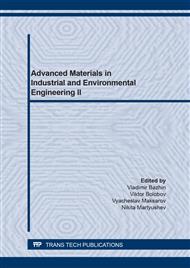[1]
V. Bazhin, Modern view of anomalies in groups of metals of Peridic system of D.I. Mendeleev, Journal of Mining Institute 239 (2020) 520-527.
Google Scholar
[2]
V. Bez'yazychny, M. Scherek, Development of thermal process research in mechanical engineering technology, Journal of the Mining Institute 232 (2018) 395-400.
Google Scholar
[3]
V. Meskin, Fundamentals of steel alloying, Metallurgizdat, Moscow, (1959).
Google Scholar
[4]
A. Vasilyeva, Anomaly of strength and plasticity in the intercritical interval, Metal Science and Metalworking 1 (1957) 23-29.
Google Scholar
[5]
О. Kaybyshev, Plasticity and superplasticity of metals, Metallurgy, Moscow, (1957).
Google Scholar
[6]
Е. Savitsky, Influence of Temperature on Mechanical Properties of Metals and Alloys, AS USSR, Moscow, (1957).
Google Scholar
[7]
T. Takeuchi, Workhardening of iron single crystals between 25º and 900ºC, Jap. Jorn. applied physics 9 (1970) 391-400.
Google Scholar
[8]
G. Titov, The phenomenon of thermal embrittlement in WIT-iron, Metalurg 8 (1937) 15-25.
Google Scholar
[9]
B. Mogutnov, Thermodynamics of iron-carbon alloys, Metallurgy, Moscow, (1972).
Google Scholar
[10]
V. Grigorovich, Electronic structure and thermodynamics of iron alloys, Nauka, Moscow, (1970).
Google Scholar
[11]
V. Alexeev, B. Barakhtin, A. Zhukov, Chemical heterogeneity as a factor of increasing the strength of steels made by selective laser melting technology, Memoirs of Mining Institute 242 (2020) 191-196.
DOI: 10.31897/pmi.2020.2.191
Google Scholar
[12]
V. Tsukanov, N. Lebedeva, Yu. Markova, Conditions of austenite diffusion transformation passage in Cr-3Ni-Mo-V-composition steel with high austenite stability, Notes of Mining Institute 230 (2018) 153-159.
Google Scholar
[13]
N. Gudtsov, Metallurgy and heat treatment. Handbook edited by N. Gudtsov, Metallurgizdat, Moscow, (1957).
Google Scholar
[14]
N. Esser, Dilotometrische und magnetische untersuchungen an reinem eisen und eische-kohlinstoff-legirungen, Stahe und Eisen 47(9) (1927) 336-344.
Google Scholar
[15]
R. Bozort, Ferromagnetism, International Literature Publishing, Moscow, (1956).
Google Scholar
[16]
B. Livshits, Physical Properties of Metals and Alloys, Mashgiz, Moscow, (1959).
Google Scholar
[17]
A. Schulze, Uber eine besandere erscheinung bei umwandlungen, die sich über ein temperaturgebiet erstecken, Zeitschrift fur metallcunde 27(11) (1935) 251-255.
Google Scholar
[18]
R. Powell, Further measurments of the thermal and electrical conductivity of iron at high temperatures, The proceedings of the physical society 51(3(285)) (1939) 407-418.
DOI: 10.1088/0959-5309/51/3/304
Google Scholar
[19]
N. Hirschowitsch, Crystallisation and properties of cast iron, Mechanical Engineering, Leningrad, (1966).
Google Scholar
[20]
F. Korber, Thermodinamic considerations on some equilibrium curves of the iron-carbon state diagram, Archive for the iron metallurgy 11 (1932) 569-578.
Google Scholar
[21]
P. Obergoffer, Technical Iron, Metallurgizdat, Moscow, (1940).
Google Scholar
[22]
V. Schastlivcev, D. Mirzaev, Perlite in carbon steels, URO RAN, Moscow, (2006).
Google Scholar
[23]
A. Rakhstadt, Spring steels and alloys, Metallurgy, Moscow, (1982).
Google Scholar
[24]
I. Novikov, Theory of heat treatment of metals, third ed., Metallurgiya, Moscow, (1978).
Google Scholar
[25]
L. Moroz, Fine structure and strength of steel, Metallurgizdat, Moscow, (1957).
Google Scholar
[26]
E. Gudremon, Special steels, Metallurgizdat, Moscow, (1959).
Google Scholar
[27]
Yu. Ustinovshchikov, Secondary hardening of structural alloy steels, Metallurgy, Moscow, (1982).
Google Scholar
[28]
D. Chirkst, On the life and work of Academician N.S. Kurnakov, Notes of the Mining Institute 202 (2013) 9-13.
Google Scholar
[29]
С. Sanin, N. Pelipenko, Innovative technology for manufacturing large-sized products, Notes of the Mining Institute 230 (2018) 185-189.
Google Scholar
[30]
V. Maksarov, V. Krasnyy, The formation of surface roughness of piston rings for the purpose of improving the adhesion of wear-resistant coatings, Key Engineering Materials 736 (2017) 73-78.
DOI: 10.4028/www.scientific.net/kem.736.73
Google Scholar
[31]
A. Makarov, V. Schastivtsev, T. Tabachnikova, Wear resistance of eutectoidal carbon steels with austenite isothermal decomposition structure, FMM 97(5) (2004) 94-105.
Google Scholar
[32]
V. Izotov, Segregation of dispersed vanadium carbides at the interface during pearlitic steel transformation, FMFM 111(6) (2011) 619-625.
Google Scholar
[33]
L. Utevskij, Tempering brittleness of steel, Metallurgizdat, Moscow, (1961).
Google Scholar
[34]
V. Sadovsky, Residual austenite in hardened steel, Nauka, Moscow, (1986).
Google Scholar
[35]
M. Lozinskij, High-temperature metallography, Mashgiz, Moscow, (1956).
Google Scholar


